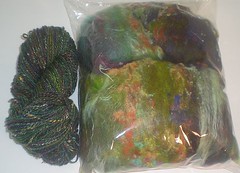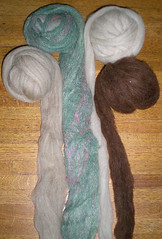 By Amelia © August 22, 2009
By Amelia © August 22, 2009When you go to a show or fiber store for the first time, all the different types of fiber can be overwhelming ... there are batts, roving, fleece, top; wool of various breeds, silk, cotton, blends, and more. Shown to the right is a skein of handspun and a Crosspatch Batt, Greens and Purples.
For starters, it's worth noting that the particular fiber prep on the label may not be accurate; top may be labeled roving or vice-versa, as those two look the same (from across the room, anyway).
 Commercial top is a very dense preparation, very smooth in appearance. It’s machine combed. Hand-combed top is airy and done in small amounts, typically (in fact I don’t think I’ve ever seen anyone selling hand-combed top… it’s pretty labor intensive). Hand-dyed commercial top can tend to have a “wavy” appearance, as the wetting/warming re-awakens the fibers somewhat.
Commercial top is a very dense preparation, very smooth in appearance. It’s machine combed. Hand-combed top is airy and done in small amounts, typically (in fact I don’t think I’ve ever seen anyone selling hand-combed top… it’s pretty labor intensive). Hand-dyed commercial top can tend to have a “wavy” appearance, as the wetting/warming re-awakens the fibers somewhat.In the picture left/above, we have 4 preparations: combed top, roving, pin-drafted roving, and sliver. Pin-drafted is machine drafted out finer than the original roving. There is also pencil roving, which is drafted out to a pencil width.
Batts are big fluffy rectangles of fiber. Sometimes rolled up and banded or bagged in sale-type situations. These can be all one fiber, a blend, layered, striped (see my blog post How do I card a self-striping batt? for the last one). There are big machines that make big batts, and there are people with table-top drum carders who make individual batts (in the 1-4 oz size, typically).
Roving is carded on a carding machine with twist inserted; if no twist is inserted, it’s “sliver”, but folks don’t often label it that way. It’s fluffier than the combed top, though I have seen fairly compressed roving as well. It can be as fat as the commercial top or also quite fine – it depends on the equipment used to make it.
 Fleece is really big (several pounds, usually, unlike the small fleece from my Soay shown here), smelly, and in a plastic bag usually. Well, smelly if it’s unwashed. It may or may not be skirted, may or may not have faults – best to go sit in on a fleece judging, or buy fleeces that have been judged (and read the judge’s comments on it before you buy). Or express an interest, I'd be happy to do a blog post on "what to look for in a fleece". Sometimes you can find washed fleece or dyed locks (mohair, typically).
Fleece is really big (several pounds, usually, unlike the small fleece from my Soay shown here), smelly, and in a plastic bag usually. Well, smelly if it’s unwashed. It may or may not be skirted, may or may not have faults – best to go sit in on a fleece judging, or buy fleeces that have been judged (and read the judge’s comments on it before you buy). Or express an interest, I'd be happy to do a blog post on "what to look for in a fleece". Sometimes you can find washed fleece or dyed locks (mohair, typically).Most top, batts, roving, or fleece is wool; the breed may be noted, or it may have a note on it like "medium wool" or "50s wool" (that's not a reference to its year of shearing, by the way). Here, you can in part let your hand be your guide, if you aren't yet familiar with the breeds. Wensleydale is coarse, Coopworth and Romney are medium wools, Corriedale is medium/fine, and Merino is fine ... there are so many sheep breeds out there, though, so learn to trust your fingertips. Within a breed there's a huge variety -- Merino can run from "fine" to aaaaaaa-fiiiiine, for example. It will always be softer than Wensleydale, though. For further information on this see How do I know what sheep breeds to look for?
Cloud is a prep you often see with cashmere, camel, or pygora; this is typically de-haired but otherwise unprocessed fiber. Well, dehairing is actually a carding type of operation, so it’s pretty airy usually. You can spin cloud by the handfull if you like, you don’t need to prep it further.
Then there are just fibers in baggies or pick-your-favorite-containers labeled with content and weight – flash & angelina come to mind. They don’t really have a “prep” per se, they just “are”.
Silk is usually sold as a top, sliver, hanky, cap, or brick. The hanky and cap are stretched out coccoons; the brick is a bunch of caps as I recall; there’s also a really big prep called a “bell” which is several/many pounds of silk caps, and it looks like the Liberty Bell (really big!). Top and sliver are the same prep, they are cut lengths of silk all combed up nicely (then there’s reeled silk, but that’s not usually sold to spinners; and silk waste, silk noil, sari silk …)
Cotton is usually sold as sliver, either combed or carded (typically carded, but sometimes combed), or as punis, which are hand-carded, rolled up sausages put in a bundle and sold by weight.
Whew! Probably there are others, too … feel free to add to this list in the comments for this blog post, or ask questions about the information here.
~~
I realize I've posted on this topic before, in several separate blog posts; this was written to help out some new spinners on Ravelry heading to their first fiber shows (how exciting!). Here are related earlier posts:
What's the difference between Batts, Roving, and Top?
What's the difference between Roving and Top?
To drumcard, to handcard, or to comb?
How do I know what sheep breed to look for?
~~
© 22 August 2009 by Ask The Bellwether, posted at http://askthebellwether.blogspot.com/
